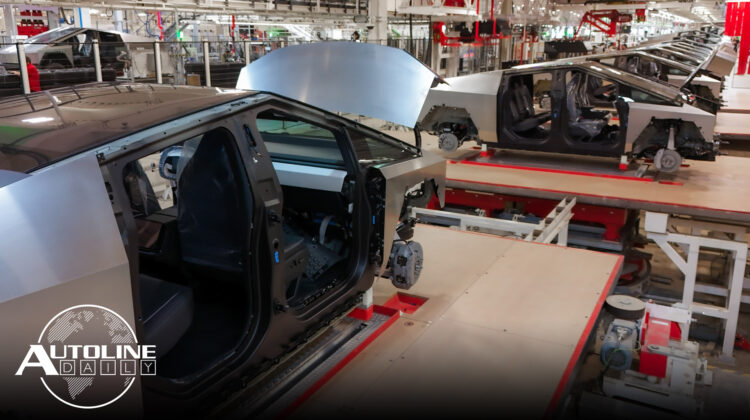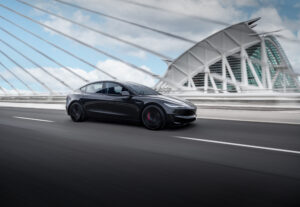
Follow us on social media:
Runtime: 10:07
0:00 Tesla’s Stock Up Despite Q1 Earnings Drop
2:37 Tesla Gives Model 3 A Performance Boost
3:16 LG Chem & Factorial Partner on Solid-State Batteries
4:39 Mercedes Reveals All-Electric G-Class
5:55 Euro NCAP To Start Crash Testing Heavy-Duty Trucks
6:53 Subaru Axes Legacy from U.S. Lineup
7:35 Polestar Considers Selling U.S. Built Cars in EU
8:19 VW Aiming For 15% Market Share in China
Visit our sponsor to thank them for their support of Autoline Daily: Bridgestone, Intrepid Control Systems and Teijin Automotive.
This is Autoline Daily, the show dedicated to enthusiasts of the global automotive industry.
TESLA’S STOCK UP DESPITE Q1 EARNINGS DROP
It feels like Tesla dropped a bomb of information on the auto industry last night. At the core of it was the EV maker’s Q1 results, which were down, yet its stock was up over 10% today in pre-market trading. So, let’s dive in. Tesla delivered nearly 387,000 vehicles, which was down 9%. Worse, it’s building a lot more vehicles than it’s selling. It made over 433,000 EVs in Q1, which means it had over 46,500 vehicles of excess capacity. The vehicles it did sell, plus its energy storage, Supercharging and other services brought in $21.3 billion in revenue, also down 9%. So, why was Tesla stock up? Because it provided a ton of details about its upcoming plans that investors seemed to really like. One of the big pieces of news is that Tesla says it’s accelerated the launch of new models that were originally supposed to start production in the second half of next year. Those EVs will include “more affordable models.” But they will not use its complete “unboxed” assembly process. Instead, they will use both aspects of the next-gen platform as well as parts from the current platform. This means it won’t reduce vehicle costs as much as it thought it would, but will allow it to grow volumes more efficiently and utilize more of its current production capacity, which is around 3 million vehicles. Tesla says its robotaxi is the model that will continue to pursue the “unboxed” assembly process. But it sounds like even before the robotaxi will launch, Tesla will integrate a ride-hailing function into the Tesla App that’s benefiting from more owners using FSD, which was offered as a free 30-day trial earlier this year and then Tesla just lowered the price significantly. On top of that Tesla again said that it’s in talks with a major automaker to license FSD tech, which we previously speculated might be Ford because of Elon Musk and Jim Farley’s somewhat close relationship. And Musk says Tesla may also start selling its Optimus robot next year, which it plans to start using in its own facilities this year. So, you can probably see why some investors are excited.
TESLA GIVES MODEL 3 A PERFORMANCE BOOST
And if that weren’t enough, the new Model 3 Performance was revealed. At its heart is a dual-motor AWD drive system that produces 510 horsepower and provides a 0-60 time of 2.9 seconds. But it’s also much more than that. It features performance springs, dampers, bushings, stabilizer bar, sports brakes and seats and owners can customize handling balance, stability control and regenerative braking from the center screen. Pricing starts just under $53,000 before any incentives.
LG CHEM & FACTORIAL PARTNER ON SOLID-STATE BATTERIES
Solid-state batteries are getting a boost. LG Chem is lending its battery building know-how to solid-state battery startup Factorial. The two announced that they signed an understanding to accelerate the development of solid-state battery materials. LG already supplies batteries to most of the global automakers and Factorial counts Mercedes, Stellantis and Hyundai as partners.
MERCEDES REVEALS ALL-ELECTRIC G-CLASS
Mercedes revealed the all-electric version of the new G-Class. It’s powered by four individually controlled electric motors located near the wheels that combine for 432 kW or nearly 580 horsepower. They provide acceleration from 0-100 km/h in 4.7 seconds as well as what Mercedes called G-Turn, which we think is like a tank turn. The battery pack has a usable capacity of 116 kWh and provides up to 473 kilometers or 293 miles. So this is not going to be a very efficient vehicle at roughly 30-28 kWh/100 km or 2-2.2 miles/ kWh. The best EVs today are twice as efficient. Off-road ability has always been a trademark of the G-Class and the new EV version still uses independent front suspension with double wishbones and a newly developed rigid rear axle. As of right now we don’t see any word when the electric G-Class will launch, but it will be offered as a global vehicle.
EURO NCAP TO START CRASH TESTING HEAVY-DUTY TRUCKS
Heavy-duty trucks account for 3% of all vehicles on European roads but they’re involved in 15% of all traffic deaths. That’s why the Euro NCAP, which crash tests and hands out safety ratings for passenger vehicles in Europe, is soon going to add heavy-duty trucks to its tests. And here’s how it will evaluate them. The new tests will mimic real world conditions, for both city and highway driving, and encourage OEMs to equip their trucks with crash avoidance technologies and improve driver vision. In the future, the tests will include crash protection as well. Euro NCAP says it consulted with a number of companies and government officials to craft the rules, which were designed to be both cost-effective and deliver on safety. Euro NCAP will release the final rules next month and in November it will release the first ratings.
SUBARU AXES LEGACY FROM U.S. LINEUP
Subaru announced that it’s dropping the Legacy from its lineup in the U.S. The automaker said production will end in spring of 2025 for the longest running model in its lineup. The sedan is built at the company’s plant in Indiana and 1.3 million have been sold in the U.S. since its debut in 1989. Subaru says it’s discontinuing the Legacy because of car buyers shifting away from sedans to SUVs and crossovers as well as the company’s transition to electric vehicles. Subaru is planning to have eight EVs in its lineup by 2028, including the Solterra which went on sale in 2022.
POLESTAR CONSIDERS SELLING U.S. BUILT CARS IN EU
As we’ve reported, Europe is unhappy with the wave of Chinese built EVs entering the market. But it’s not just concerned about Chinese brands, it doesn’t want European brands doing the same thing. So, Europe’s investigation into Chinese made EVs could lead to tariffs for any brand that imports EVs from China to Europe. So to avoid those possible tariffs, Polestar’s CEO says it’s considering shipping vehicles built in the U.S. to Europe instead of from China. Polestar, which is owned by Geely, builds the majority of its vehicles at two plants in China but it also started production of its Polestar 3 model at Volvo’s plant in South Carolina this year.
VW AIMING FOR 15% MARKET SHARE IN CHINA
Volkswagen used to be the number one brand in China but it was overtaken by BYD in late 2022. VW’s market share has fallen from 19% in 2020 to 14.5% last year. So the automaker says it’s working to make sure its share remains in the 15% range. It believes it can do so thanks to a new R&D hub in China and partnerships with EV makers to create more affordable EVs. That 15% market share translates to selling 4 million vehicles a year in China by 2030, last year VW sold just over 3 million vehicles. While it likely won’t be able to regain its title of the best-selling brand in China, VW says it’s aiming to remain the number one foreign brand.
But that brings us to the end of today’s show. Thanks for making Autoline a part of your day.
Thanks to our partner for embedding Autoline Daily on its website: WardsAuto.com









Subaru is in for rude awakening . That Solterra is a dud. They can’t even give it away as a loaner. When I took my wife’s Crosstrek in for inspection they give us a loaner for the day. The girls asked what we wanted, I said what do you have? She said everything but a BRZ or WRX we even have the EV for a loaner. I said “no thanks” , to which she said “:yeah no one wants it”
and they want to pollute their line up with 7 more in 3 years time. Say goodbye to all those great sales years.
XA351GT,
If your use during the service period allows for it, you should take the EV next time. I use those EV service loaners to understand the positives and negatives of that model and EVs in general. Ultimately I am not buying it and it is always fun to try new things with cars. That of course would assume I was only driving it back and forth to work. If I was taking their service loaner on a long trip, well, I would have refused the EV lol.
The future of EVs in the US is really going to depend heavily on the Nov election. Even if Biden can garner a second term, I’m not sure the public demand will support the saturation he’s looking for. So, the pushing back of ICE bans will likely happen regardless of who’s in office. If he loses then even more relaxed mandates could be expected. It’s going to be a tough time for all automakers to have the proper mix available to meet customer demand and government regulations. Automakers seem to embrace the EV movement even more than the general public. Not sure if that’s political butt kissing or if they truly believe demand will materialize. If they go all in, they could be in a world of hurt when they have no ICE vehicles to offer. Good news is China doesn’t seem to be interested in exporting anything but EVs. End result could be China dominating the EV market and Ford and GM left with gas trucks and large SUVs. Either way the next 2 years is going to be interesting.
I think there’s two reasons for higher EV success in different markets around the world.
The first is savings on transportation. This is harder to quantify because an EV is more expensive than the ICE equivalent, so you need to be longer term focussed than many people are. This reason is why I believe the big step towards EVs will be commercial vehicles. Most companies do the math and not just look at purchase price. As well, slightly more inconvenient operation can often be overcome with standards and procedures. Almost all countries outside the U. S. have much higher gas prices so this helps the EV argument.
The second reason is a concern about climate change and a feeling you have some responsibility for your fellow man and to provide a good world for future generations. The health benefits of fewer ICE engines are well documented but they don’t show up immediately or in many cases personally. In most countries it’s not political.
I still feel EV’s will become popular. Many people have come to the conclusion that only home owners should be the early adopters as public charging posts are not reliable not to mention that last winter many of them weren’t functioning. The transition is going to take time and that will be by the end of the decade. Also, range anxiety is still there and the manufacture that can achieve 500 to 700 miles will be the winner.
If I were offered an EV as a loaner, I’d be glad to have it if it came with enough charge for the duration of the loan.
Quote from today’s FT:
BYD, Tesla’s largest rival, announced that it planned to bring its ultra-cheap Seagull EV to Europe and the UK from next year. The vehicle, which sells for less than $10,000 in China, has caused near-panic among western carmakers, who argue they simply cannot compete with such prices.
“It will be a European-market Seagull, a new Seagull,” BYD senior executive Stella Li told reporters, including the UK’s Auto Express, in Shenzhen.
Unquote. What’s nice about small EVs is that they don’t have to feel like the budget option. Instant, smooth, and relatively abundant low-end torque does not cost a lot of money anymore.
I’m also intrigued by the appearance of hybrids where the electric motor is paired with the transmission.
Earl- I dont think pursuing 500-700 mile range is the answer. I mean that would be a nice solution if some magic battery is developed but when you consider the weight and how most people use their vehicles. Going back and forth to work on average is a 41-mile commute, according to the census bureau. So, 100-mile range would get a person to work for two days on a charge. If you can plug in at home every night that 100 mile range would provide almost all your driving needs. Thats why I feel like a plug-in hybrid with 100 mile range is the proper fit until we do have a reliable charging network and better batteries. The range anxiety is gone and you have a vehicle that only needs gas on the rare occasions you travel more than 100 miles.
I mean gas vehicles dont typically have more than 400 miles of range so I doubt they will try and exceed that with EV’s that already are significantly heavier with 300 miles of range. But yeah if a battery gets developed that can provide 700 miles of range and weigh less than 700lbs that would be great. I just dont see that happening anytime soon.
Public charging needs to be reliable, and cheaper. The average cost of public charging in the US is $0.45/kWh. At those rates, operating cost would be lower for efficient gas cars, especially hybrids, than for EVs.